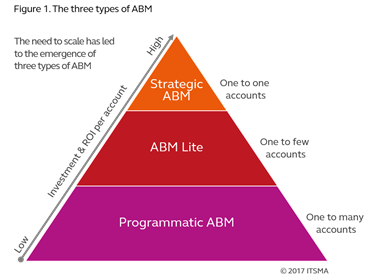In 2020, Forrester predicted a 30% uplift in ABM programs in 2021, and as we enter this new year we thought it would be a good time to look back at the conception of ABM, and why those core principles still matter today. ITSMA, a leading authority in B2B, pioneered the concept of Account Based Marketing back in 2004 to try and bring an end to the generic sales pitches of the day, and instead focus on the essential needs of their most important clients. Before we dive into their methodology in doing this, let’s first define ABM.
What is ABM?
ABM is a business strategy made up of marketing initiatives involving email, social, media placement, PR, events and more, into a targeted set of prospect or customer accounts. It is not just another branch of an organisation’s marketing capability; it encompasses all the marketing processes in an overarching strategy, centring on the intrinsic alignment of Marketing and Sales around the customer. Essentially it is just good, targeted marketing.
What is ITSMA’s methodology?
ITSMA created a methodology which centres on 4 key principles:
- Client-centricity and insight: Outside-in problem solving, not sales pitches
- Marketing and Sales partnership: Full collaboration for an integrated approach
- Reputation, relationships and growth: Objectives beyond just near-term revenue
- Tailored programs and campaigns: Personalized propositions, content, and programs to drive interest and engagement
These principles can be summarised into what are essentially Sales and Marketing led, targeted and personalised customer lifecycles. Sales and Marketing working together to create an end to end customer experience which focuses on specific customer needs is what forms the core of any strong ABM strategy.
3 approaches to ABM – The ABM Pyramid

There are three types of ABM and before any effective ABM strategy begins, you need to segment your data set into these categories of communication:
- Strategic ABM: 1:1 marketing. You create content and messaging hyper-specific to that one account. You may even have marketers whose full-time job is just to market to that account.
- ABM Light: 10-15 key accounts – clustered through vertical or accounts with very similar characteristics.
- Programmatic ABM: 100 plus accounts – very light touch ABM.
Adopting any of the above approaches will aid in both Sales and Marketing alignment, because by the very nature of ABM it forces the two teams together, as well as improving the effectiveness and quality of your Sales strategy, whilst also creating a better customer experience. If you want to find out more about the nuances of selecting your ABM target accounts, such as the importance of data in any ABM strategy, then download our guide below.
5 Challenges to Successful ABM
If you're looking for support in choosing the right accounts, we are a 75 strong team of data, marketing and technology specialists who can analyse and structure your ABM data and program. Get in touch here to find out more.


